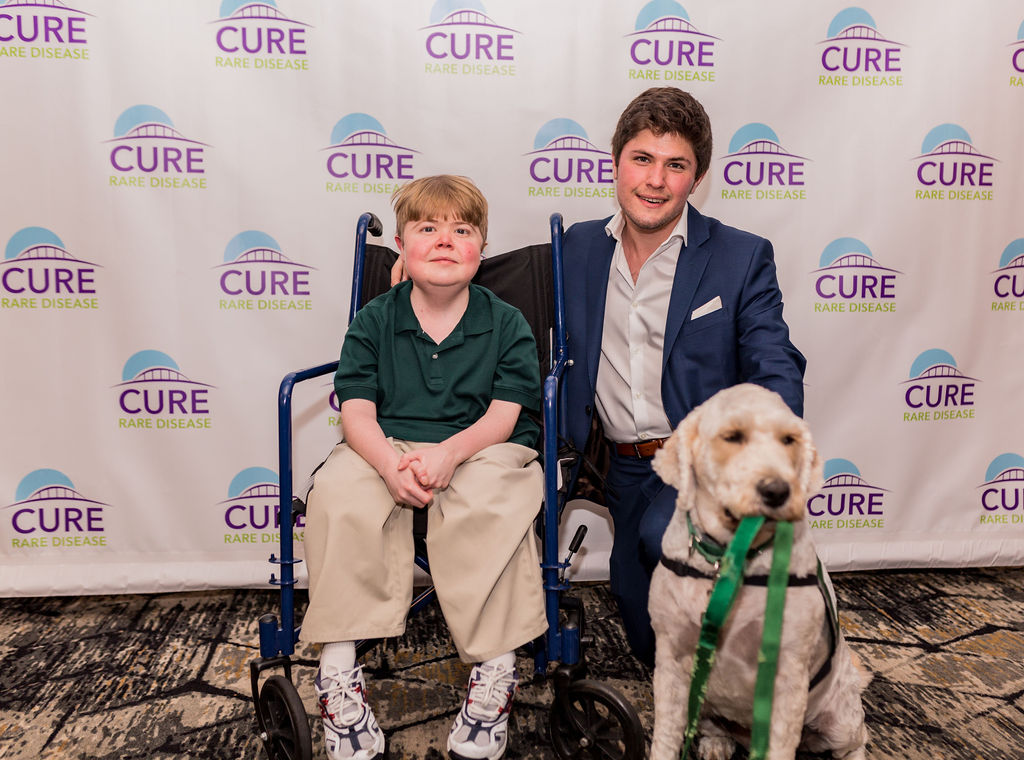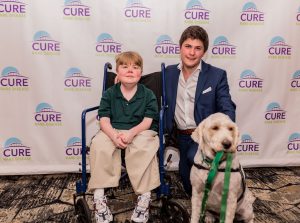Cure Rare Disease’s Rich Horgan Pioneers Customized Medicine to Treat Brother with DMD

Rich and Terry Horgan pose at a Cure Rare Disease event (Photo courtesy of Cure Rare Disease)
Rich Horgan’s younger brother, Terry Horgan, is the inspiration behind Cure Rare Disease, a Boston-based nonprofit Rich established in 2017 to help scientists develop personalized therapies for people with rare diseases.
Terry, 24, has Duchenne muscular dystrophy (DMD), which is the organization’s first focus. Besides Terry, three other patients are in line to receive customized medicine.
Cure Rare Disease is “on the cusp of a major breakthrough,” said Rich, 28, a recent graduate of Harvard Business School.
Scientists partnered with Cure Rare Disease will insert CRISPR activation into the harmless adeno-associated virus (AAV) delivery system early this year. The CRISPR/Cas9 system is a gene editing tool that can be used to modify or correct genetic mutations in patient cells.
The approach will be tested in mice bred with the mutated human version of DMD — the altered gene in people with Duchenne. If all goes well, the next step is getting the therapy to Terry, which the nonprofit says would be the first in vivo, or in the body CRISPR activation ever performed in the United States.
“It’s a cool thing to think about the first part of this journey’s first finish line in dosing Terry,” Rich said. “To be able to give him a bit more independence would be really powerful and give him a lot more joy.”
Two exon-skipping therapies, Exondys 51 (eteplirsen) and Vyondys 53 (goloirsen), both developed by Sarepta Therapeutics, have been approved by the U.S. Food and Drug Administration (FDA) for Duchenne patients with mutations in specific exons — the tiny bits of DNA that contain information to make proteins. In this case, that protein is dystrophin, which is needed for muscles to function properly but is missing or found in very small amounts in people with Duchenne.
Exondys 51 is intended for the nearly 13% of patients carrying mutations in exon 51 of DMD. Meanwhile, Vyondys 53 has been designed to treat people with alterations in exon 53.
But neither therapy is indicated for Terry, as his disease-causing alteration is in exon 1. That makes him a candidate for personalized therapy.
Timothy Yu, a neurologist at Boston Children’s Hospital, was one of the earliest adopters of customized medicine for Batten disease, a very rare inherited neurological illness. Within a year, Yu sequenced a patient’s DNA, analyzed the results, and manufactured and delivered the treatment.
Rich Horgan met Yu through Massachusetts Institute of Technology (MIT) professor John Fleming, with Yu becoming a key advisor for Cure Rare Disease’s approach to treating Terry.
Rich compares individualized treatment development to a relay race, where the first runner hands off to the second. He started with a biopsy by geneticist Stanley Nelson at the University of California-Los Angeles (UCLA). Monkol Lek, PhD, from the Yale School of Medicine, developed a CRISPR activation strategy. Within six to seven months, Cure Rare Disease had a proof of concept and a CRISPR mechanism that could fit within the AAV packaging.
“Harvard taught me that while you may not be able to do the science, you can enable people to come together,” Horgan said. “You can paint the vision. You can bring this collective group together and orient them in a direction that is going to generate and create positive success.”
According to Horgan, Cure Rare Disease has raised over $1 million and enjoys the backing of global philanthropist and billionaire Len Blavatnik. The organization now works with 15 researchers at seven institutions. Cure Rare Disease also is working on FDA policy for individualized medicine, as well as insurance reimbursement and a database containing information from mice on different Duchenne mutations.
However, it hasn’t been easy to convince people that this new personalized treatment development strategy will work, Rich Horgan said.
“We see what a small group of highly dedicated, highly passionate and highly motivated people can do versus a large group,” he said. “It doesn’t have to be a 10-year and $2 billion wait for a lifesaving drug.”
The price of customized medicine is comparable to therapies developed by large companies, according to Rich Horgan. The entire process for Terry’s treatment cost around $2 million. The spinal muscular atrophy (SMA) gene therapy Zolgensma — developed by Novartis and approved last year by the FDA — retails for $2.125 million.
Getting Terry the treatment he needs would allow other organizations and small businesses to follow suit, he said, adding: “If we can start to prove success in different mutations and do so quickly and safely, I think it opens up a lot of potential for others to do the same, not only for Duchenne but other rare diseases.”







